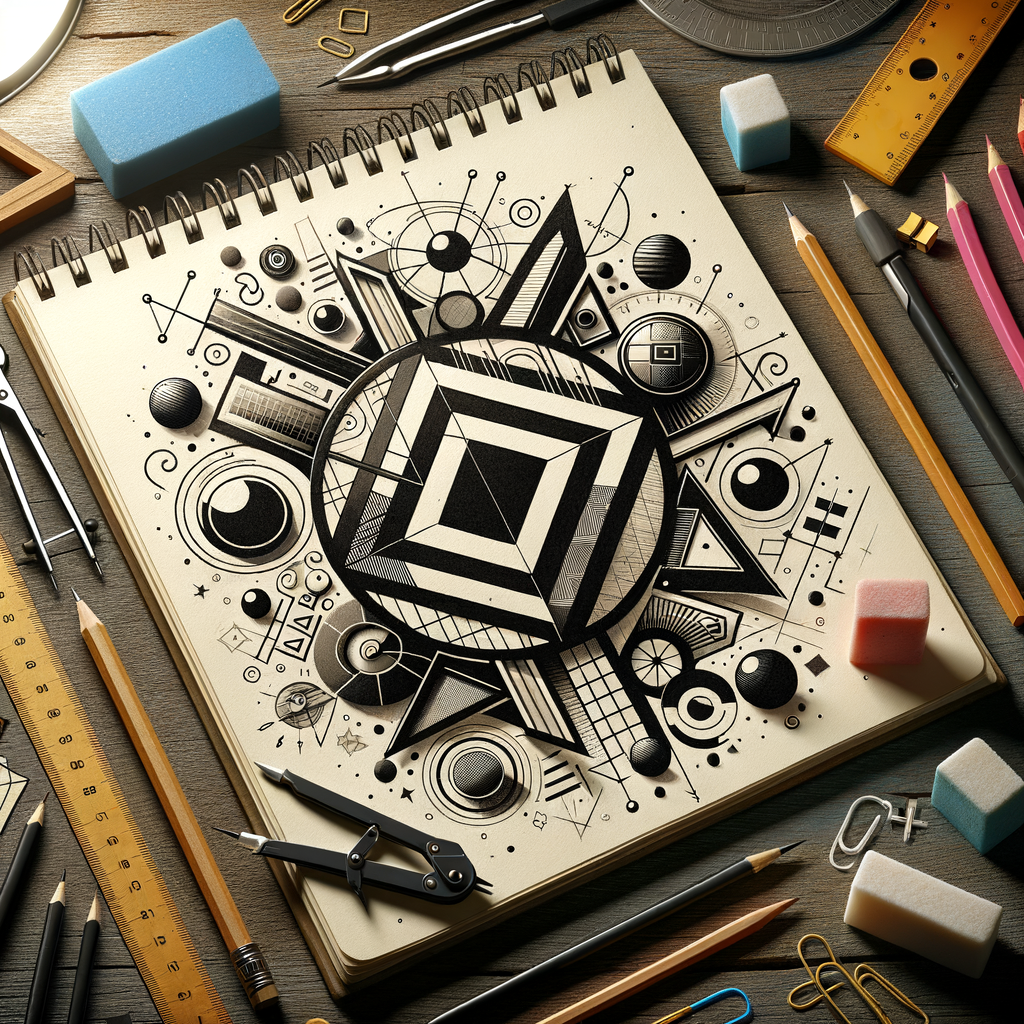
Geometric Logo Design: Stunning Prompts For Effortless Creativity
- The Allure of Geometric Logo Design
- Understanding Geometric Shapes
- What Are Geometric Shapes?
- The Role of Shapes in Branding
- Choosing the Right Color Palette
- The Power of Color
- Creating a Harmonious Palette
- Exploring Typography in Geometric Logos
- The Intersection of Shapes and Fonts
- Balancing Fonts and Shapes
- Geometric Fonts to Consider
- Finding Inspiration for Geometric Logos
- Nature and Geometry
- Architecture as a Guide
- Stunning Geometric Design Prompts
- Combining Shapes Creatively
- Using Overlapping Shapes
- Playing with Symmetry
- Abstract Geometric Patterns
- Practical Tips for Designing Geometric Logos
- Start with Sketches
- Utilize Design Software
- Seek Feedback
- Testing Your Logo Design
- Checking Versatility
- Solicit Target Audience Opinions
- The Future of Geometric Logo Design
- Embracing Minimalism
- Sustainability and Eco-Friendly Designs
- Conclusion: Unleash Your Creativity
- Frequently Asked Questions (FAQs)
- References
The Allure of Geometric Logo Design
Geometric logo design has gained immense popularity over recent years. Simple yet powerful, these logos combine shapes, lines, and angles to create a memorable identity for brands. Many companies utilize geometric forms to convey professionalism, stability, and creativity. Whether you’re a seasoned designer or a novice, understanding geometric logos can spark effortless creativity in your work.
Moreover, using geometry helps capture attention. Rounded shapes evoke friendliness, while sharp angles suggest modernity and innovation. This versatility allows businesses to express their unique identities while appealing to a broad audience. Let’s explore stunning prompts that unleash your creativity in geometric logo design.
Understanding Geometric Shapes
What Are Geometric Shapes?
Geometric shapes include circles, squares, triangles, and polygons. They create a structured look. Each shape carries its meaning and emotional weight. For instance, circles symbolize unity and harmony, while squares often represent stability and trust. Triangles can indicate progress and direction. Understanding these nuances helps you choose the right shapes for your designs.
The Role of Shapes in Branding
Brands leverage shapes to communicate messages. A tech company might favor sharp angles to convey innovation, while a wellness brand might use rounded shapes for a more nurturing feel. When designing a logo, think carefully about the emotions you want to evoke. Choose shapes that align with your brand’s mission.
Choosing the Right Color Palette
The Power of Color
Color significantly impacts perception and identity. In geometric logo design, choosing a color palette becomes pivotal. Each color evokes emotions. For example, blue is often associated with trust, and red can represent passion.
Creating a Harmonious Palette
To create a visually appealing logo, select colors that complement each other. Use tools like Adobe Color or Coolors to generate harmonious palettes. Consider using a primary color with one or two accent colors. This approach keeps the design clean and eye-catching.
Exploring Typography in Geometric Logos
The Intersection of Shapes and Fonts
Typography plays a crucial role in logo design. Choosing a font that aligns with your geometric shapes creates a cohesive look. Sans-serif fonts often complement geometric designs well due to their clean lines. For example, pairing a circular logo with a rounded font enhances the softness and approachability of your brand.
Balancing Fonts and Shapes
When balancing fonts and geometric shapes, keep legibility in mind. The logo needs to be recognizable, even at smaller sizes. Aim for simplicity and clarity. Too many fonts can create visual clutter, detracting from the geometric forms.
Geometric Fonts to Consider
Below is a list of popular geometric fonts:
| Font Name | Characteristics |
|——————|———————————-|
| Futura | Clean lines, modern aesthetic |
| Helvetica | Versatile, neutrality |
| Montserrat | Bold, strong presence |
| Poppins | Rounded, friendly feel |
| Avenir | Contemporary, professional style |
Finding Inspiration for Geometric Logos
Nature and Geometry
Nature brims with geometric forms. From the hexagonal structure of honeycombs to the symmetry in flowers, inspiration awaits everywhere. Observe shapes and patterns around you. Sketch ideas on paper or capture photos to reference later.
Architecture as a Guide
Architecture showcases stunning geometric designs. Consider visiting urban environments or famous landmarks. Draw parallels between architectural elements and logo concepts. This approach expands your creative repertoire.
Stunning Geometric Design Prompts
Combining Shapes Creatively
Experimentation is key in geometric logo design. Try combining basic shapes in unexpected ways. For example, merge a triangle with a circle to create a new, unique shape. This prompt encourages exploration beyond traditional design boundaries.
Using Overlapping Shapes
Overlapping shapes can produce intriguing visual effects. Use transparency to combine different geometric elements. This technique can create depth and add interest to your logo.
Playing with Symmetry
Symmetrical designs often catch the eye. Create a logo featuring symmetrical shapes for balance and harmony. Consider how reflection affects your design. Play with mirror imagery or rotational symmetry for added creativity.
Abstract Geometric Patterns
Don’t shy away from abstract designs. Mixing various geometric elements can lead to a compelling graphic. Create patterns using lines and shapes that reflect your brand’s ethos. This methodology emphasizes uniqueness and creativity.
Practical Tips for Designing Geometric Logos
Start with Sketches
Begin your design process with pencil and paper. Sketch various ideas without overthinking. This technique encourages creativity and allows for the flow of ideas. Once you have a few promising sketches, you can move into digital design.
Utilize Design Software
Software like Adobe Illustrator or CorelDRAW offers tools tailored for geometric designs. Create clean lines and manipulate shapes with ease. Familiarize yourself with key features like the pen tool and shape builder to enhance your workflow.
Seek Feedback
Don’t hesitate to gather feedback. Share your designs with peers or potential customers. Constructive feedback helps refine your work and ensures your logo resonates with your target audience.
Testing Your Logo Design
Checking Versatility
Your logo should perform well across different mediums. Test its appearance in print and on various digital platforms. Does it maintain clarity at different sizes? Ensure it looks great in black and white as well.
Solicit Target Audience Opinions
Understanding how your logo connects with your target audience is vital. Conduct surveys or focus groups to gather impressions. If your logo fails to resonate, be prepared to iterate and make changes.
The Future of Geometric Logo Design
Embracing Minimalism
Minimalism continues to thrive in design trends, and geometric logos align perfectly. Simple shapes convey messages without overwhelming the viewer. Embrace white space and clean lines to enhance your design’s effectiveness.
Sustainability and Eco-Friendly Designs
As awareness grows around sustainability, brands that reflect eco-friendly values through design will stand out. Consider using earthy colors or nature-inspired shapes in your geometric logo designs. This strategy helps create a connection with environmentally conscious consumers.
Conclusion: Unleash Your Creativity
Embracing geometric logo design opens doors to a world of creativity. By understanding shapes, colors, and typography, you can craft logos that resonate with your audience. Use the prompts and tips discussed to push boundaries and explore innovative approaches.
Remember, the best designs often stem from experimentation and openness to new ideas. So grab your tools and let your imagination guide you to effortless creativity in geometric logo design.
Frequently Asked Questions (FAQs)
1. What is a geometric logo?
A geometric logo uses shapes like circles, squares, and triangles to create a clean, modern design that communicates a brand’s identity.
2. Why use geometric shapes in logos?
Geometric shapes convey professionalism, stability, and creativity, making them effective for branding.
3. How do I choose the right colors for a geometric logo?
Consider the emotions each color evokes and select complementary colors that align with your brand’s message.
4. Can I use serif fonts with geometric shapes?
While sans-serif fonts typically pair well with geometric shapes, creative use of serif fonts can work too if they complement the design.
5. How can I find inspiration for my geometric logo designs?
Look to nature, architecture, and art for inspiration. Experiment with sketches based on these elements.
6. What software should I use for designing geometric logos?
Popular software includes Adobe Illustrator, CorelDRAW, and free alternatives like Inkscape and Canva for beginners.
7. How important is feedback in the logo design process?
Feedback is crucial; it helps identify strengths and weaknesses in your design and ensures it resonates with your target audience.
8. Should my logo look the same in color and black-and-white?
Yes, a successful logo should be recognizable and effective in both color and black-and-white formats.
9. What makes a geometric logo timeless?
A timeless geometric logo usually combines simplicity, versatility, and strong symbolic meanings that resonate across cultures and generations.
10. How often should I redesign my logo?
Redesign your logo only when necessary. Major branding shifts or a noticeable shift in company values may warrant updates.
References
– Logo Design Love
– Canva’s Logo Maker
– Adobe Color
– Coolors Color Palette Generator
– Creative Bloq – Logo Design Tips

